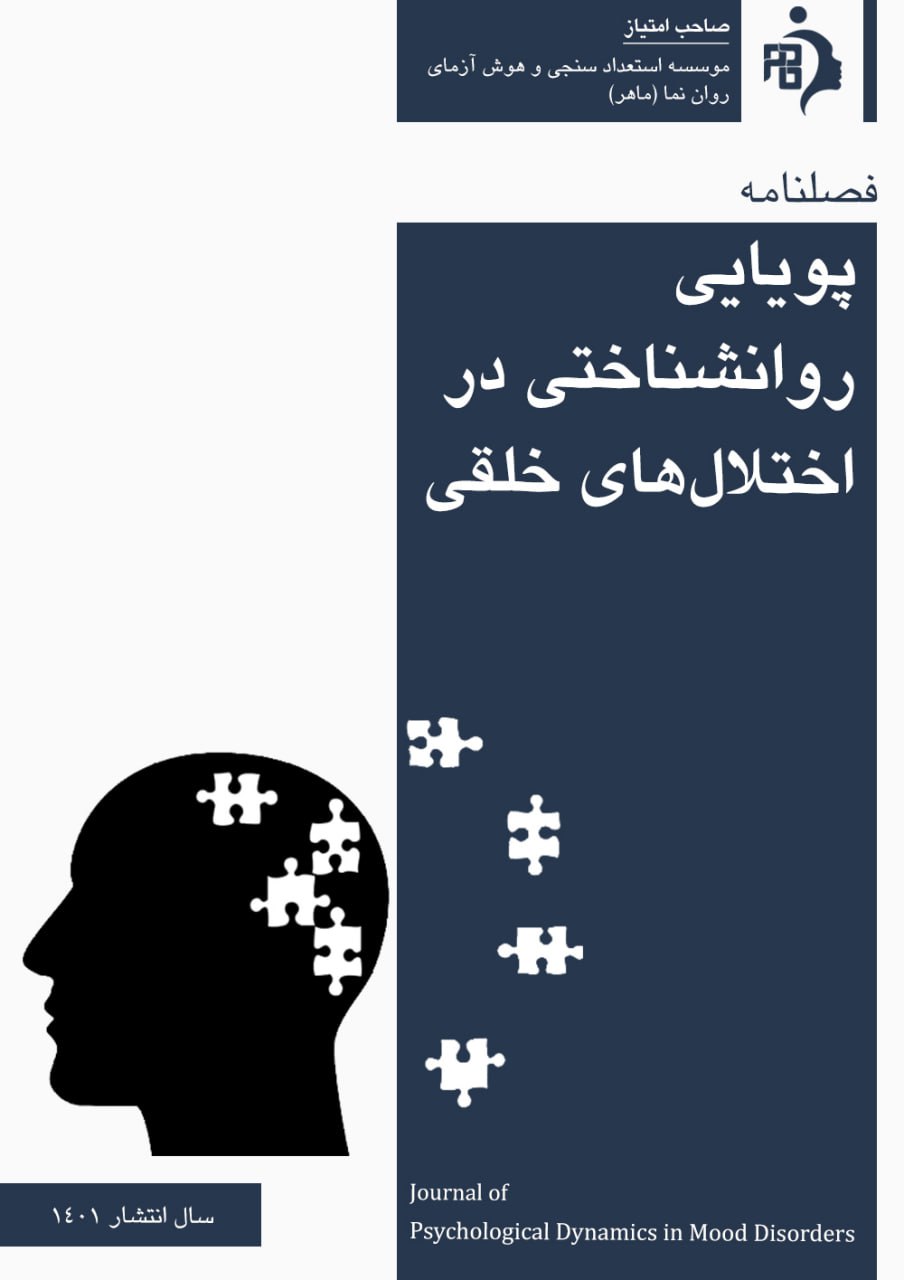نقش واسطهای قلدری سایبری و خودکارآمدی در رابطه صفت هوش هیجانی و سازگاری با مدرسه در نوجوانان
کلمات کلیدی:
هوش هیجانی, قلدری سایبری, خودکارآمدی, سازگاری با مدرسه, نوجوانانچکیده
هدف: هدف پژوهش حاضر بررسی نقش واسطهای قلدری سایبری و خودکارآمدی در رابطه میان صفت هوش هیجانی و سازگاری با مدرسه در میان نوجوانان بود. روششناسی: این پژوهش از نوع کاربردی و از نظر ماهیت همبستگی با استفاده از مدلیابی معادلات ساختاری انجام شد. جامعه آماری شامل دانشآموزان مقطع متوسطه بود که به روش نمونهگیری در دسترس انتخاب شدند. دادهها با استفاده از پرسشنامه صفت هوش هیجانی پترایدز و فارنهام (2001)، پرسشنامه خودکارآمدی موریس (2001)، پرسشنامه تجربه قلدری–قربانی سایبری آنتونیادو و همکاران (2016) و پرسشنامه سازگاری دانشآموزان سینها و سینگ (1993) گردآوری شد. دادهها با نرمافزارهای SPSS و AMOS تحلیل گردید و شاخصهای برازش و آزمون بوتاسترپ با 5000 تکرار برای بررسی مسیرهای میانجی مورد استفاده قرار گرفت. یافتهها: نتایج نشان داد صفت هوش هیجانی اثر مثبت و معناداری بر خودکارآمدی (β = 0.71, p < 0.001) و اثر منفی بر قلدری سایبری (β = -0.28, p < 0.01) و قربانی سایبری (β = -0.24, p < 0.01) دارد. همچنین، خودکارآمدی اثر منفی معناداری بر سازگاری با مدرسه داشت (β = -0.36, p < 0.001) و قلدری سایبری (β = 0.38, p < 0.001) و قربانی سایبری (β = 0.26, p < 0.01) بهطور مثبت با کاهش سازگاری مرتبط بودند. اثر کل صفت هوش هیجانی بر سازگاری با مدرسه منفی و معنادار بود (β = -0.51, p < 0.001) که بخشی از آن از طریق نقشهای میانجی خودکارآمدی و قلدری سایبری تبیین شد. نتیجهگیری: یافتهها نشان میدهد که صفت هوش هیجانی از طریق ارتقاء خودکارآمدی و کاهش درگیری در قلدری سایبری، نقش مهمی در سازگاری تحصیلی و اجتماعی نوجوانان دارد. طراحی مداخلات آموزشی و روانشناختی برای تقویت هوش هیجانی و خودکارآمدی و پیشگیری از قلدری سایبری میتواند سازگاری نوجوانان با محیط مدرسه را بهبود بخشد.
دانلودها
مراجع
Asdolahzadeh, P., Sadeghi, J., & Abbasi Asfajir, A. A. (2021). Modeling the Structural Equations of Mode Metacognition with a Tendency to Cyberspace Mediated by Self-efficacy in Gifted Students [Research Article]. Iranian Journal of Educational Sociology, 4(2), 14-23. https://doi.org/10.52547/ijes.4.2.14
Chemers, M. M., Hu, L.-t., & Garcia, B. F. (2001). Academic self-efficacy and first year college student performance and adjustment. Journal of Educational Psychology, 93(1), 55-64. https://doi.org/10.1037/0022-0663.93.1.55
Cheung, C. (2019). Parents’ Involvement and Adolescents’ School Adjustment: Teacher–student Relationships as a Mechanism of Change. School Psychology, 34(4), 350-362. https://doi.org/10.1037/spq0000288
Cohen-Almagor, R. (2018). Social responsibility on the Internet: Addressing the challenge of cyberbullying. Aggression and Violent Behavior, 39, 42-52. https://doi.org/10.1016/j.avb.2018.01.001
Dorol--Beauroy-Eustache, O., & Mishara, B. L. (2021). Systematic review of risk and protective factors for suicidal and self-harm behaviors among children and adolescents involved with cyberbullying. Preventive Medicine, 152, 106684. https://doi.org/10.1016/j.ypmed.2021.106684
Hong, J. S., Kim, D. H., Thornberg, R., Kang, J. H., & Morgan, J. T. (2018). Correlates of direct and indirect forms of cyberbullying victimization involving South Korean adolescents: An ecological perspective. Computers in human Behavior, 87, 327-336. https://doi.org/10.1016/j.chb.2018.06.010
Lim, J., & Huh, Z. (2024). Relationship Between Parental Monitoring and Cyberbullying Perpetration Among Male and Female Adolescents: Dual Sequential Mediating Effects of Self-Control and Peer Conformity of Anti-Social Behaviors. Korea University Institute of Educational Research, 91, 139-165. https://doi.org/10.24299/kier.2024.372.139
Lim, Y. (2022). Structural Relationships Among Dual-Earner Parents’ Work-Family Conflict, Co-Parenting Quality, Children’s Executive Function Difficulties, and School Adjustment: An Application of the Actor-Partner Interdependence Model. Family and Environment Research, 60(4), 507-520. https://doi.org/10.6115/fer.2022.034
Lim, Y., & Lee, O. (2017). Relationships between Parental Maltreatment and Adolescents’ School Adjustment: Mediating Roles of Self-Esteem and Peer Attachment. Journal of Child and Family Studies, 26(2), 393-404. https://doi.org/10.1007/s10826-016-0573-8
Majidi, R., Shahni Yilag, M., & Haghighi Mobarake, J. (2015). The causal relationships of emotional and general intelligence with school performance, mediated by test anxiety and school adjustment in high school students of Borujerd. Training & Learning Researches, 12(1), 1-18. https://www.magiran.com/paper/1527586
Martínez, I., Murgui, S., Garcia, O. F., & Garcia, F. (2019). Parenting in the digital era: Protective and risk parenting styles for traditional bullying and cyberbullying victimization. Computers in human Behavior, 90, 84-92. https://doi.org/10.1016/j.chb.2018.08.036
Ng, E. D., Chua, J. Y. X., & Shorey, S. (2020). The Effectiveness of Educational Interventions on Traditional Bullying and Cyberbullying Among Adolescents: A Systematic Review and Meta-Analysis. Trauma, Violence, & Abuse, 23(1), 132-151. https://doi.org/10.1177/1524838020933867
Ofem, U. J. (2023). Adjustment Tendencies Among Transiting Students: A Mediation Analysis Using Psychological Wellbeing Indices. International Journal of Education and Cognitive Sciences, 4(3), 1-19. https://doi.org/10.61838/kman.ijecs.4.3.1
Perren, S., Corcoran, L., Mc Guckin, C., Cowie, H., Dehue, F., Völlink, T., Garcia, D., Sevcikova, A., & Tsatsou, P. (2012). Tackling cyberbullying: Review of empirical evidence regarding successful responses by students, parents, and schools. https://leicester.figshare.com/articles/journal_contribution/Tackling_cyberbullying_Review_of_empirical_evidence_regarding_successful_responses_by_students_parents_and_schools/10153814
Safaria, T., & Suyono, H. (2020). The Role of Parent-Child Relationship, School Climate, Happiness, and Empathy to Predict Cyberbullying Behavior. International Journal of Evaluation and Research in Education, 9(3), 548-557. https://doi.org/10.11591/ijere.v9i3.20299
Saraei, A. (2015). Testing structural relationships between classroom goal structures, social self-efficacy, perfectionism, social achievement goals, and school adjustment Shahid Beheshti University].
Trompeter, N., Bussey, K., & Fitzpatrick, S. (2018). Cyber Victimization and Internalizing Difficulties: The Mediating Roles of Coping Self-Efficacy and Emotion Dysregulation. Journal of abnormal child psychology, 46(5), 1129-1139. https://doi.org/10.1007/s10802-017-0378-2
Wang, C., Xia, Y., Li, W., Wilson, S. M., Bush, K., & Peterson, G. (2016). Parenting behaviors, adolescent depressive symptoms, and problem behavior: The role of self-esteem and school adjustment difficulties among Chinese adolescents. Journal of Family Issues, 37(4), 520-542. https://doi.org/10.1177/0192513X14542437
Zhang, Y. (2024). The Influence of Media Violence Exposure on Cyberbullying Among Adolescents: The Mediating Role of Parental Monitoring. Hc, 1(10). https://doi.org/10.61173/69a8wm57
Zhao, F., Zhang, H., Li, S., Wu, H., & Hou, J. (2024). Exploring the Relationship Between Paternal Co‐parenting Behaviors and Cyberbullying Perpetration in Chinese Adolescents: The Moderating Roles of Psychological Entitlement and Gender. Psychology in the Schools, 61(8), 3193-3211. https://doi.org/10.1002/pits.23210
دانلود
چاپ شده
ارسال
بازنگری
پذیرش
شماره
نوع مقاله
مجوز
حق نشر 2025 الیکا نیکویه, ابوطالب سعادتی شامیر, علیرضا محمدی آریا (Author)

این پروژه تحت مجوز بین المللی Creative Commons Attribution-NonCommercial 4.0 می باشد.









